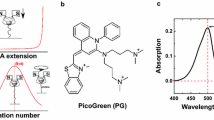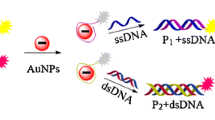Abstract
A sensitive and straightforward method for discriminating between surface-adsorbed double-stranded DNA (dsDNA) and single-stranded DNA (ssDNA), based on analysis of the fluorescence emission spectra of DNAs dyed with the metachromatic dye acridine orange, has been developed. Since the degree of discrimination between dsDNA and ssDNA is dependent on dye-base ratio (as has been shown in early studies of DNAs in solution), a specific, reproducible protocol for obtaining good ss-ds discrimination was needed. We studied the emission spectra for DNAs dyed in-situ on two different surfaces, polymethylmethacrylate and poly-l-lysine, using acridine orange solutions of varying concentrations in either 2-(N-morpholino)ethanesulfonic acid (MES) or Tris–Borate EDTA (TBE) buffers. The method should prove useful in characterizing the efficacy of denaturing techniques applied to surface-adsorbed DNAs in preparation for hybridization, replication and transcription experiments on stretched and aligned DNAs.







Similar content being viewed by others
References
Armstrong JA, Niven JSF (1957) Fluorescence microscopy in the study of nucleic acids. Nature 180:1235–1236
Bradley DF, Wolf MK (1959) Aggregation of dyes bound to polyanions. Proc Natl Acad Sci U S A 45(7):944–952
Stone AL, Bradley DF (1961) Aggregation of acridine orange bound to polyannions—stacking tendency of deoxyribonucleic acids. J Am Chem Soc 83(17):3627–3628
Nash D, Plaut W (1964) On denaturation of chromosomal DNA in situ. Proc Natl Acad Sci U S A 51:731–715
Bradley DE (1965) Staining of bacteriophage nucleic acids with acridine orange. Nature 205:1230–1230
Ichimura S, Zama M, Fujita H, Ito T (1969) Nature of strong binding between acridine orange and deoxyribonucleic acid as revealed by equilibrium dialysis and thermal renaturation. Biochim Biophys Acta 190(1):116–125
Ichimura S, Zama M, Fujita H (1971) Quantitative determination of single/stranded sections in DNA using fluorescent probe acridine orange. Biochim Biophys Acta 240(4):485–495
Stockert JC, Lisanti JA (1972) Acridine–orange differential fluorescence of fast– and slow reassociating chromosomal DNA after in-situ DNA denaturation and reassociation. Chromosoma 37:117–130
Pal MK, Ghosh AK (1973) Stoichiometry of metachromatic dye binding by deoxyribonucleic acid. Histochemie 36:29–33.
Ichimura S (1975) Differences in red fluorescence of acridine –orange bound to single–stranded RNA and DNA. Biopolymers 14(5):1033–1047
Darzynkiewicz Z, Traganos F, Sharpless T, Melamed MR (1975) Thermal denaturation of DNA insitu as studied by acridine –orange staining and automated cytofluorometry. Exp Cell Res 90(2):411–428
Darzynkiewicz Z, Evenson D, Kapuscinski J, Melamed MR (1983) Denaturation of RNA and DNA insitu induced by acridine –orange. Exp Cell Res 148(1):31–46
Kapuscinski J, Darzynkiewicz Z, Melamed MR (1983) Interactions of acridine–orange with nucleic–acids—properties of complexes of acridine–orange with single stranded ribonucleic–acid. Adv Biochem Pharmacol 32(24):3679–3694
Bernas T, Asem EK, Robinson JP, Cook PR, Dobrucki JW (2005) Confocal fluorescence imaging of photosensitized DNA denaturation in cell nuclei. Photochem Photobiol 81(4):960–969
Hotz MA, Gong JP, Traganos F, Darzynkiewicz Z (1994) Flow cytometric detection of apoptosis—comparison of the assays of in-situ DNA–degradation and chromatin changes. Cytometry 15:237–244
Dobrucki J, Darzynkiewicz Z (2001) Chromatin condensation and sensitivity of DNA in situ to denaturation during cell cycle and apoptosis—a confocal microscopy study. Micron 32:645–654
Evenson DP, Darzynkiewicz Z, Melamed MR (1980) Relation of mammalian sperm chromatin heterogeneity to fertility. Science 210:1131–1133
Evenson DP, Jost LK, Baer RK, Turner TW, Schrader SM (1991) Individuality of DNA denaturation patterns in human sperm as measured by the sperm chromatin structure assay. Reprod Toxicol 5:115–125
Zini A, Bielecki R, Phang D, Zenzes MT (2001) Correlations between two markers of sperm DNA integrity, DNA denaturation and DNA fragmentation in fertile and infertile men. Fertil Steril 75:674–677
Liu DY, Baker HWG (2007) Human sperm bound to the zona pellucida have normal nuclear chromatin as assessed by acridine orange fluorescence. Hum Reprod 22:1597–1602
Darzynkiewicz Z, Traganos F, Sharpless T, Melamed MR (1977) Different sensitivity of DNA insitu in interphase and metaphase chromatin to heat denaturation. J Cell Biol 73:128–138
Darzynkiewicz Z, Traganos F, Sharpless T, Melamed MR (1977) Interphase and metaphase chromatin—different stainability of DNA with acridine –orange after treatment at low pH. Exp Cell Res 110:201–214
Darzynkiewicz Z, Traganos F, Carter SP, Higgins PJ (1987) Insitu factors affecting the stability of the DNA helix in interphase nuclei and metaphase chromosomes. Exp Cell Res 176:168–179
Lerman LS (1961) Structural considerations in interaction of DNA and acridines. J Mol Biol 3:18–30
Gersch NF, Jordan DO (1965) Interaction of DNA with aminoacridines. J Mol Biol 13:138–156
Macinnes JW, Uretz RB (1966) Organization of DNA in dipteran polytene chromosomes as indicated by polarized fluorescence microscopy. Science 151:689–691
Neville DM, Davies DR (1966) Interaction of acridine dyes with DNA—an X-ray diffraction and optical investigation. J Mol Biol 17:57–74
Drummond DS, Pritchar NJ, Simpson VF, Peacocke AR (1966) Interaction of aminoacridines with deoxyribonucleic acid—viscosity of complexes. Biopolymers 4:971–987
Rigler R (1966) Microfluorometric characterization of intracellular nucleic acids and nucleoproteins by acridine orange. Acta Physiol Scand Suppl 267:1–122
Mauss Y, Chambron J, Daune M, Benoit H (1967) Etude Morphologique Par Diffusion De La Lumiere Du Complexe Forme Par Le Dna Et La Proflavine. J Mol Biol 27:579–589
Blake A, Peacocke AR (1968) Interaction of aminoacridines with nucleic acids. Biopolymers 6:1225–1253
Armstron RW, Strauss UP, Kurucsev T (1970) Interaction between acridine dyes and deoxyribonucleic acid. J Am Chem Soc 92:3174–3181
Sakoda M, Hiromi K, Akasaka K (1972) Kinetic studies on acridine orange DNA interaction—branched mechanism involving intercalation and outside dimerization. J Biochem 71:891–896
Frederic E, Houssier C (1972) Study of interaction of DNA and acridine –orange by various optical methods. Biopolymers 11:2281–2308
Kapuscinski J, Darzynkiewicz Z (1984) Denaturation of nucleic–acids induced by intercalating agents—biochemical and biophysical properties of acridine –orange DNA complexes. J Biomol Struct Dyn 1:1485–1499
Kapuscinski J, Darzynkiewicz Z (1984) Denaturation of nucleic–acids induced by intercalating agents—biochemical and biophysical properties of acridine –orange DNA complexes. J Biomol Struct Dyn 1(6):1485–1489
Kure N, Sano T, Harada S, Yasunaga T (1988) Kinetics of the interaction between DNA and acridine –orange. Bull Chem Soc Jpn 61:643–653
Darzynkiewicz Z, Kapuscinski J (1990) Acridine orange: a versatile probe of nucleic acids and other cell constituents. Flow cytometry and sorting, 2nd edn. Wiley- Liss, New York, pp 291–314
Okumura H, Akane T, Tsubo Y, Matsumoto S (1997) Comparison of conventional surface cleaning methods for Si molecular beam epitaxy. J Electrochem Soc 144(11):3765–3768
Bensimon A, Simon A, Chiffaudel A, Croquette V, Heslot F, Bensimon D (1994) Alignment and sensitive detection of dna by a moving interface. Science 265:2096–2098
Bensimon D, Simon AJ, Croquette V, Bensimon A (1995) Stretching DNA with a receding meniscus—experiments and models. Phys Rev Lett 74(23):4754–4757
Michalet X, Ekong R, Fougerousse F, Rousseaux S, Schurra C, Hornigold N, Vanslegtenhorst M, Wolfe J, Povey S, Beckmann JS, Bensimon A (1997) Dynamic molecular combing: stretching the whole human genome for high–resolution studies. Science 277:1518–1523
Liu YY, Wang PY, Dou SX, Wang WC, Xie P, Yin HW, Zhang XD (2004) Ionic effect on combing of single DNA molecules. and observation of their force–induced melting by fluorescence microscopy. J Chem Phys 121(9):4302–4309
Liu YY, Wang PY, Dou SX (2007) Single–molecule studies of DNA by molecular combing. Prog Nat Sci 17(5):493–499.
Conti C, Sacca B, Herrick J, Lalou C, Pommier Y, Bensimon A (2007) Replication fork velocities at adjacent replication origins are coordinately modified during DNA replication in human cells. Mol Biol Cell 18(8):3059–3067
Kim J, Hoon J, Shi WX, Larson RG (2007) Methods of stretching DNA molecules using flow fields. Langmuir 23(2):755–764
Parra I, Windle B (1993) High–resolution visual mapping of stretched DNA by fluorescent hybridization. Nat Genet 5(1):17–21
Schwartz DC, Li XJ, Hernandez LI, Ramnarain SP, Huff EJ, Wang YK (1993) Ordered restriction maps of Saccharomyces–Cerevisiae chromosomes constructed by optical mapping. Science 262:110–114
Wang YK, Huff EJ, Schwartz DC (1995) Optical mapping of site–directed cleavages on single DNA–molecules by the reca –assisted restriction–endonuclease technique. Proc Natl Acad Sci U S A 92(1):165–169
Fransz PF, Alonsoblanco C, Liharska TB, Peeters AJM, Zabel P, Dejong JH (1996) High–resolution physical mapping in arabidopsis thaliana and tomato by fluorescence in situ hybridization to extended DNA fibers. Plant J 9(3):421–430
Yokota H, Johnson F, Lu HB, Robinson RM, Belu AM, Garrison MD, Ratner BD, Trask BJ, Miller DL (1997) A new method for straightening DNA molecules for optical restriction mapping. Nucleic Acids Res 25(5):1064–1070
Schwartz DC, Samad A (1997) Optical mapping approaches to molecular genomics. Curr Opin Biotechnol 8(1):70–74
Kraus J, Weber RG, Cremer M, Seebacher T, Fischer C, Schurra C, Jauch A, Lichter P, Bensimon A, Cremer T (1997) High–resolution comparative hybridization to combed DNA fibers. Hum Genet 99(3):374–380
Herrick J, Bensimon A (1999) Single molecule analysis of DNA replication. Conference: bacterial cell cycle meeting, location: Abondance, France, Date: Mar 10–14. Biochimie 81(8–9):859–871
Gueroui Z, Place C, Freyssingeas E, Berge B (2002) Observation by fluorescence microscopy of transcription on single combed DNA. Proc Natl Acad Sci U S A 99(9):6005–6010
Anglana M, Apiou F, Bensimon A, Debatisse M (2003) Dynamics of DNA replication in mammalian somatic cells: nucleotide pool modulates origin choice and interorigin spacing. Cell 114(3):385–394
Labit H, Goldar A, Guilbaud G, Douarche C, Hyrien O, Marheineke K (2008) A simple and optimized method of producing silanized surfaces for FISH and replication mapping on combed DNA fibers. Biotechniques 45(6):649–653
Czajkowsky DM, Liu J, Hamlin JL, Shao Z (2008) DNA combing reveals intrinsic temporal disorder in the replication of yeast chromosome vi. J Mol Biol 375(1):12–19
Acknowledgements
Support from the National Science Foundation (NSF-DMR 0606387 and CBET 1033623) is gratefully acknowledged. We express thanks for assistance with the experiments of I. Alsanea, G. Ho and M. Mehta.
Author information
Authors and Affiliations
Corresponding author
Rights and permissions
About this article
Cite this article
Hoory, E., Budassi, J., Pfeffer, E. et al. Discrimination of Adsorbed Double-Stranded and Single-Stranded DNA Molecules on Surfaces by Fluorescence Emission Spectroscopy Using Acridine Orange Dye. J Fluoresc 27, 2153–2158 (2017). https://doi.org/10.1007/s10895-017-2154-7
Received:
Accepted:
Published:
Issue Date:
DOI: https://doi.org/10.1007/s10895-017-2154-7




